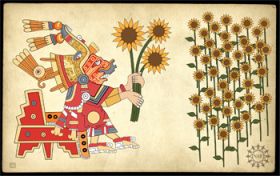Learn the origin of sunflowers
Global warming can affect one of the world's major oilseed crops - sunflower. Understanding the genetic information of early sunflowers is key to improving future harvest.
Above is the view of David Lentz, a professor of biotechnology at the University of Cincinnati in Ohio, who has been studying the origin of sunflower integration since the flower was discovered at Tabasco (Mexico). ) in 2000.
Lentz said: 'It is very difficult to get genetic information from archaeological knowledge about sunflower plants. But it is important to understand the origin of sunflower cultivation practices for breeding and conservation purposes. We need to try to preserve every bit of genetic information possible to ensure future breeding efforts. '
Lentz's sunflower discovery at the archaeological site of San Andrés of Tabasco, from 2600 BC, makes us reconsider previous insights into the process of sunflower plantation and point out places New potential reserve points.
Lentz's research report, published in the Proceedings of the National Academy of Sciences, corroborates his earlier discovery that sunflowers were introduced twice, once into the eastern Mississippi Valley, 3200 years ago, second time in Mexico 4600 years ago . This also raises debate around previous discoveries.
"One thing has been acknowledged: the main center of prehistoric botanical process lies in the history of prehistoric plants," said John Yellen, manager of the National Science Foundation's archaeological program. Central America and South America. Many archaeologists also believe that similar processes, though less well known, have appeared in North America. Dr. Lents used genetic data to directly answer this important question. '

Researchers found evidence that sunflower, Helianthus annuus, had a long history of cultivating and cultivating in Mexico, which appeared before Spain invaded in the early years of the 16th century. Seeing sunflower plants has been grown here since 2600 BC.The picture shows the artist's understanding of the history of this plant, related to the long-gone Aztec artifacts.(Photo: Zina Deretsky, National Science Foundation)
Lentz has done his research with an international team from Ohio, Florida and Mexico. He said: 'Some researchers do not want to believe that sunflowers are cultivated as a crop in Mexico before the North American period.
'They refused to believe this, although the evidence showed that Mexicans began to grow food like squash, corn and beans 10,000 years ago, in the years 8,000 BC'.
Lentz and co-authors claim their recent discovery of the three carefully preserved sunflower seed pods confirms the early colonization of the plant in Mexico.
As discussed in the 2008 report of the research team, the sunflower was discovered from 300 BC, 1800 years before the Spanish invasion of Mexico led by Hernado Cortez. They are found in a dry cave in Cueva del Gallo - the central state of Morelos (Mexico) carries the unmistakable characteristics of sunflower. Since then repelled criticism of the discovery at earlier San Andrés.
Lents said: 'We have the earliest sunflower sunflower seeds at San Andrés and there are sunflowers of great seeds in Cueva del Gallo. The precise process of Spanish history of cultivation at Aztec reinforces this statement. The more we find, the more convincing evidence we find. The assumption of integration, independent declaration is the most reasonable explanation for those evidence. '
In order to verify previous findings as well as to find new genetic resources, the team includes archaeologists, biologists and experts on the use of plants in ancient cultures to return. back to Mexico to investigate further.
They cite archaeological, linguistic data as well as descriptions from current and past Mesoamerica communities. They found that a number of indigenous population groups, such as Otomi and Nahua, had their own vocabulary in the language to talk about sunflowers without originating in Spanish with the same plants. . This shows that indigenous sunflower cultivation practices appear before the Spanish invasion since the 1500s.
The Otomi people use the name 'dä nukhä,' which translates to mean that the 'big flower facing the sun god' refers to the worship of the sun god existing even before Colombo found America. Otomi people still use sunflowers to decorate their churches.
Lentz and his colleagues argue that the Spanish invasion had a reason to limit sunflower cultivation practices in Mexico. He explained: 'In fact, they do not encourage the use of sunflower because it involves rituals and activities that Spanish priests do not allow.'
For example, sunflower plants are thought to be a strong aphrodisiac. Although there is no basis to prove it, this may partly explain the lack of evidence of sunflower in Mexico that modern scholars argue that North America is the first place to cultivate crops. this.
In addition to ancient history, there is not much to mention about sunflower in Mexico. However, the history of North America still records many evidence that sunflowers are indigenous plants. When plant breeders began experimenting on sunflowers, they took the genetic resources of sunflower from Native Americans.
Now the breeders want to look for hotter, drier climates in the south to improve the yield of sunflower crops when the effects of global warming are anticipated.
- Origin of sunflowers and sunflowers meaning in life
- Mysterious sunflowers in Van Gogh paintings
- 8m tall sunflowers
- The reason why sunflowers are facing the sun has been found
- Artificial sunflowers can bend towards the light
- The secret of sunflowers
- Japan uses sunflower plants to decontaminate soil
- The mysterious origin of the @ key
- How do birds learn to fly?
- Techniques for growing sunflowers in pots
- Back in history, learn about the origin of tea
- Sunflower does not reduce radioactivity in soil
 Why do potatoes have eyes?
Why do potatoes have eyes? 'Tragedy' the world's largest carnivorous life: Death becomes ... public toilet
'Tragedy' the world's largest carnivorous life: Death becomes ... public toilet Tomatoes were once considered 'poisonous' for 200 years
Tomatoes were once considered 'poisonous' for 200 years Detecting microscopic parasites on human face
Detecting microscopic parasites on human face